
ENGLISH
In my years as a teacher of Spanish and Literature for the third stage of Basic Education, one of the concerns that assailed me daily during my work days was the apathy I observed in children towards reading. Every day I encouraged this exercise with fragments of some stories, with the purpose of practicing reading analysis and comprehension, as well as the constant activity of writing and composition, with the purpose of encouraging them to read, taking some works as an example so that they could orient themselves through them.

For these daily tasks, I selected short texts that could capture their attention, where fantasy and adventure would catch their attention and they would want to know the whole trajectory of the reading, and of course, its ending. But the teacher's guide demanded that before the end of the school period, they should be tackling longer texts, and work on the analysis of the works based on the content adapted to each grade. In the 7th grade, I selected the work "The Little Prince" for this work, taking care of every detail so that the children would be very satisfied with the reading of long texts.
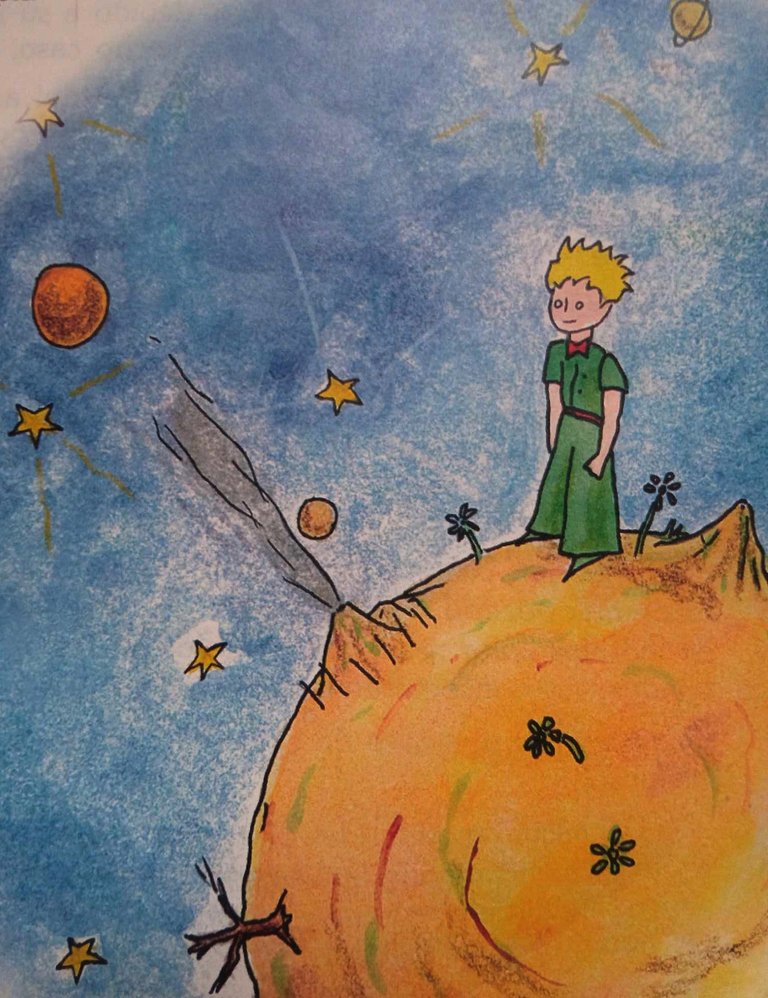
I want to share with everyone a little of this work, as a general analysis of the work, and also as a support guide for the parents of students in these three grades of Basic Education, and for themselves. This publication will address the Analysis of Narrative Texts, based on three aspects that I carefully developed for the understanding of my students.

💕 ANALYSIS OF NARRATIVE TEXTS
1.- Analysis based on the story
2.- Analysis based on discourse
3.- Analysis based on extra-literary elements

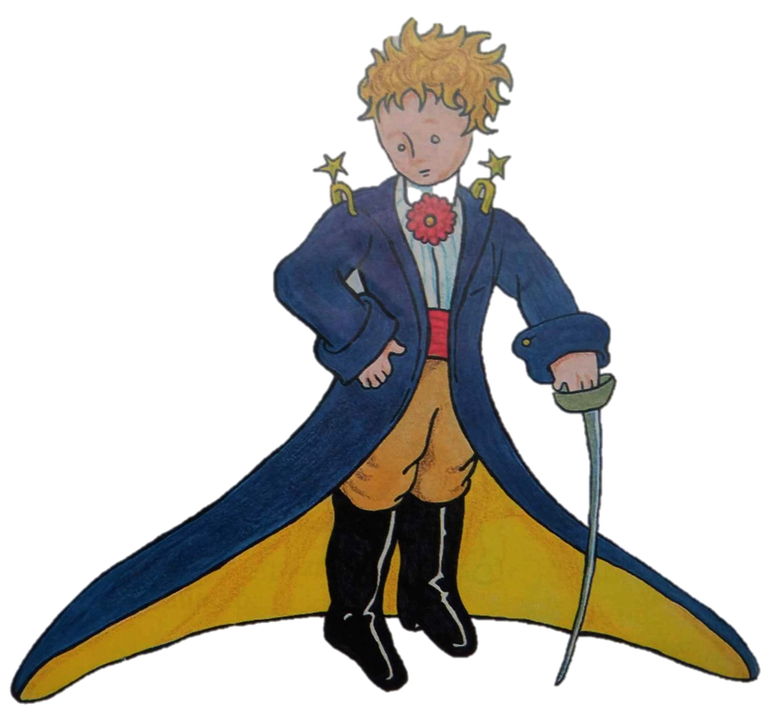
THE LITTLE PRINCE
💕 ANALYSIS BASED ON THE STORY
1.- Motive: What motivated Saint Exupery to write this work, was the moment of depression and loneliness that he was living, and little by little he was expressing in each line the varied faces of society and the absence of values in many people. The Little Prince was the one who gradually discovered the characteristics of these characters, and the rose, which the little boy loved so much, was inspired by his wife, a very beautiful woman, but vain and problematic.
2.- Characters:
-Main Character: The Little Prince.
-Secondary Characters: The pilot, the lamplighter, the king, the geographer, the vain, the fox, the rose, the businessman, the drinker, the snake and the roses.
-Referential Characters: The elephant, the little lamb and the adults.
-Collective characters: The roses and the adults.
-Helper characters: The pilot and the roses.
-Opposing characters: The rose and the snake.

3.- Environment:
-Physical: Several environments are pointed out in the work but the most relevant are the Sahara Desert, the place where the pilot and the little prince met, and the asteroid B-612, the place where the little prince lives with his rose.
-Psychological: It should be noted that this story, despite being based on a child, is mainly addressed to adults, that is, to the child who lives in them but who in most cases is asleep, or forgotten. Its context reflects a lonely child in search of friends, and who asks many questions to every adult he meets on his way, since he is unable to understand them.It also shows values and disvalues in the world, and the incomprehension towards the pilot since childhood.
4.- Sequences or actions
-The pilot begins by narrating details of his childhood and his experience as a cartoonist.
-The pilot's plane crashes in the Sahara Desert.
-The pilot has his first encounter with the little prince in the desert.
-The narrator begins to tell the story of the little prince when he lived on his planet, how he got out of there, what places he visited and who he met during the trip.
-The little prince returns to his planet.
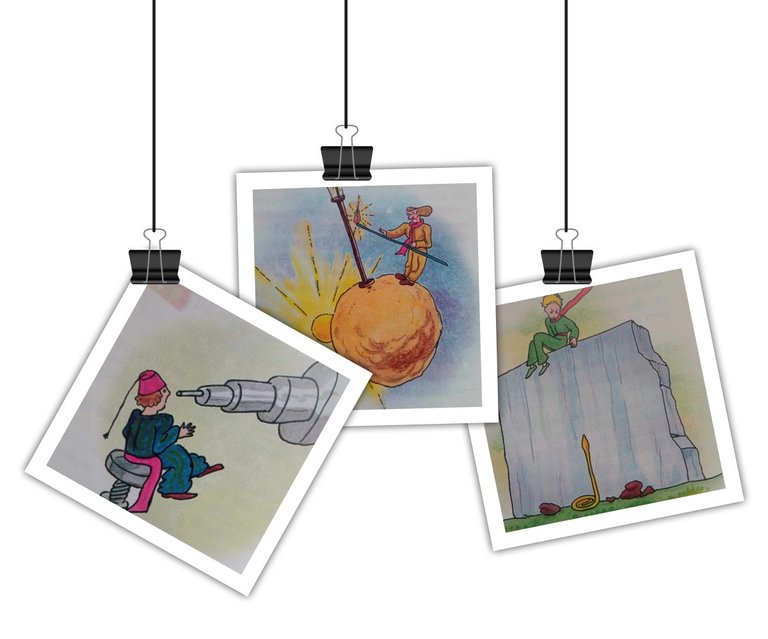
5.- Time:
The work takes place in the past tense, because the pilot narrates what happened to him, and although there are parts of the story where it is spoken in the present tense, the whole story is narrated in the past tense.

💕 DISCOURSE-BASED ANALYSIS
1.- Narrator's perspective: In this story two perspectives are reflected; a protagonist narrator (in 1st person), who begins the work narrating fragments of his own life, and of his encounter with the little prince, and an omniscient narrator (in 3rd person), who tells the story of the little prince.
2.- Speech registers: Narration, description, and dialogue.

💕 ANALYSIS OF EXTRA-LITERARY ELEMENTS
1.- Biography of the author
Antoine de Saint-Exupèry was a French novelist and aviator, who was present in World War II. He was the third of 5 children, from an aristocratic family, and because of his father, who died when he was only 4 years old, he obtained the title of Count of Saint-Exupèry.
The Little Prince was his best known work, which he wrote during the days of war and loneliness in his soul, in 1943, and which was illustrated by himself. Other works by the novelist were Mail from the South, Night Flight, War Pilot, and Letter to a Hostage, which was written in the same year as The Little Prince.
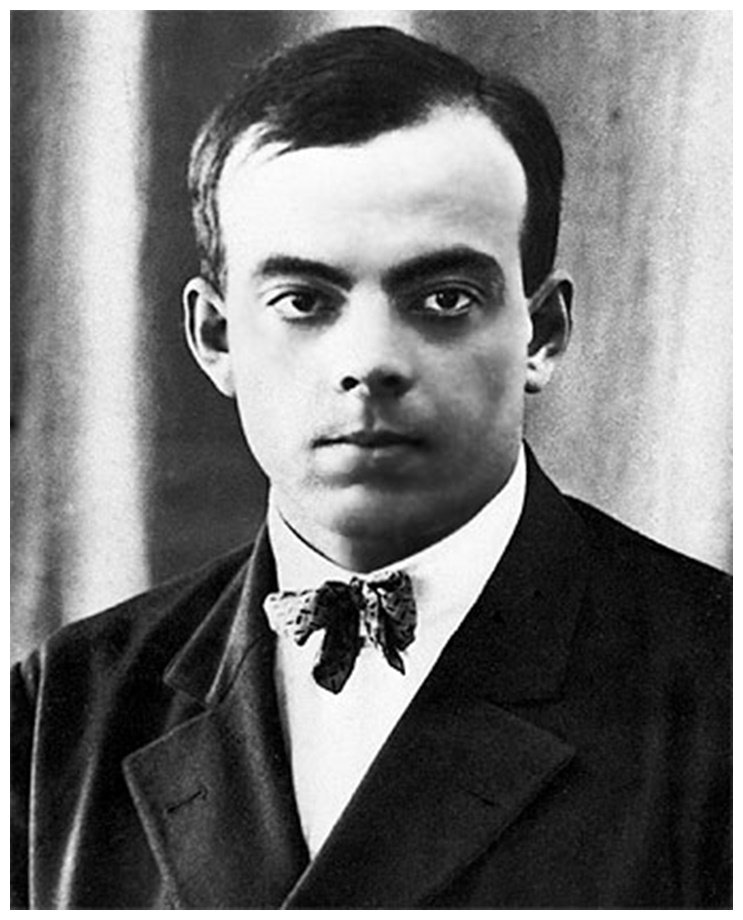
Saint-Exupèry was married to a writer, who was his muse for The Little Prince. He died in the middle of a war exercise, when his plane was supposedly shot down, and he disappeared in the Mediterranean Sea... his remains were never found.
2.- Traits of the characters that relate the author to the work.
The loneliness, the feeling of incomprehension of adults, the concern for the devalues of humanity, the desire to have a friend, to have a proud and selfish love, and the spirit of adventure.
3.- Different physical environments where the play takes place
The pilot's childhood home, the Sahara Desert, the planet of the little prince, the small planets he visited on his journey, and the planet Earth.
4.- Era at the time the work was produced
The second world war
5.- Summary of the work
The Little Prince is a short children's novel, although many categorize it as a critical tale, it could be said that it possesses a little of each of these aspects since it focuses directly, and in a fanciful way, on the confrontation of values in the midst of a society where they are absent. It begins with a brief story of the pilot as a child and the incomprehension of adults about his desire to be a painter.

Years later, he is stranded in the Sahara Desert when his plane crashed, and in that lonely place he meets a boy who becomes his first true friend, and there, in the middle of a pleasant and interesting conversation, he tells him about his contact with many people, and his adventure through several planets before arriving on Earth.
Through characters such as the lamplighter, the businessman, the vain, the fox, the roses, the king, the drinker, the geographer, and the snake, the little prince had the opportunity to know the values and disvalues that are reflected throughout the play, and it was through the roses on Earth, that he learned about selfishness and lies, since the rose he lived with on his planet, had told him that she was the only one in the world.
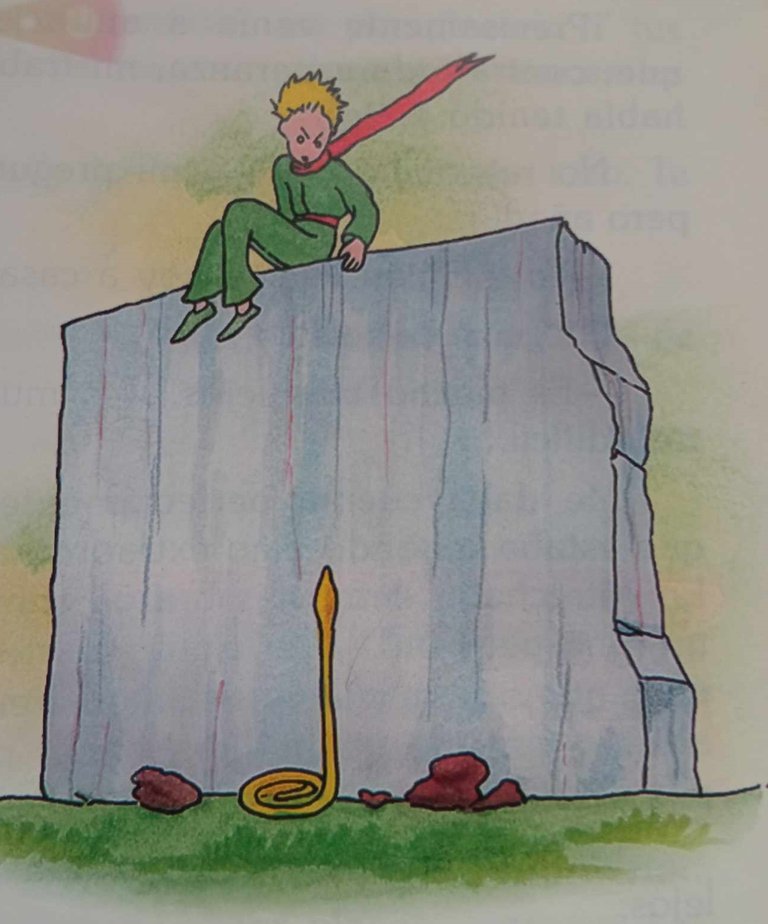
At the end of the story, and without the pilot being able to avoid it, the little prince knew evil, at the moment when the snake, making use of his innocence, tells him that he can make him return to his planet, and in this way, he receives the bite of the evil reptile.
6.- The reader's opinion about the book
The Little Prince has always reflected in my thoughts the multiple ways of knowing the absence of values in humanity against the importance of having them. The first time I read it, when I was at school, it was not a deep analysis because it did not leave a mark on me until I read it for the second time when my son was studying, and helping him to make the analysis, I fell in love not only with the little prince, but with the whole content of the work.
Some time later, I saw the movie, and I loved it, so when my work with this subject required me a play to work with the high school group, I did not hesitate to take it. It was really a beautiful experience to capture the attention of my students through this adventure, and at the same time to be able to transmit to them the importance of values in our lives. For that and more, this book will always be my favorite.

💕 QUESTION BANK:
1.- To whom did Antoine de Saint- Exupèry dedicate the work The Little Prince?
To his friend Leon Werth, when he was a child.
2.- What was the name of Saint-Exupèry's inspiring muse in this work?
Consuelo de Saint-Exupèry, his wife.
3.- Who did the little prince get on the fourth planet?
The businessman.
4.- Where did the little prince and the pilot meet?
In the Sahara Desert.
5.- What was the name of the Little Prince's planet?
Asteroid B612
6.- What did the image the pilot drew as a child represent?
A snake that swallowed an elephant.
7.- Which character did the little prince say he would have liked to live with?
With the lamplighter
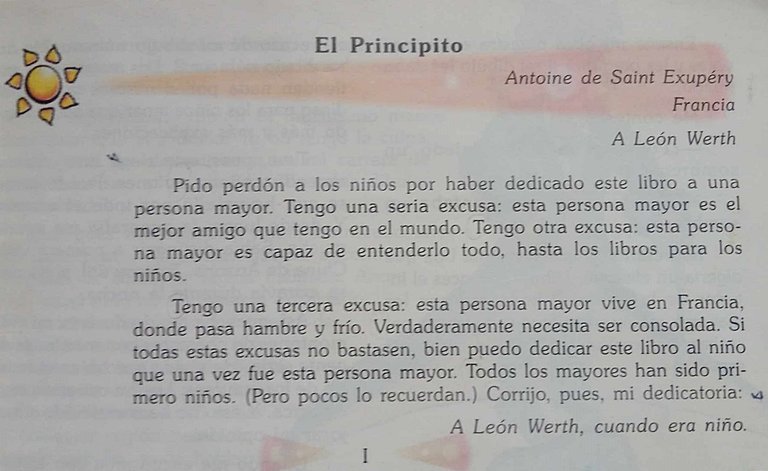
8.- Which character lives alone on his planet and is characterized by being selfish?
The vain one
9.- How does the little prince return to his planet?
By the bite of the snake.
10.- Which character asks the little prince to tame him?
The fox
11.- Who narrates the story?
The pilot
12.- What type of narrative text is The Little Prince?
A children's novel
13.- What were the names of the trees that the little prince uprooted from his planet?
Baobabs
14.- Who did the little prince live with on his planet?
With a rose

Thank you very much for visiting my blog. I hope you enjoyed this review and give me your impressions.


ESPAÑOL
En mis años de ejercicio docente, en la asignatura Castellano y Literatura para los grupos de la tercera etapa de Educación Básica, una de las preocupaciones que me asaltaba a diario durante mis jornadas laborales, era la apatía que observaba en los niños hacia la lectura. A diario fomentaba este ejercicio con fragmentos de algunos cuentos, con la finalidad de practicar el análisis y la comprensión lectora, así como también la actividad constante de redacción y composición, con el propósito de incentivarlos a leer, tomando algunas obras como ejemplo para que se orientaran a través de ellas.

Para estas tareas diarias seleccioné textos breves que pudieran captar su atención, donde la fantasía y la aventura los atrapara y quisieran conocer toda la trayectoria de la lectura, y por supuesto, su final. Pero la guía docente exigía que antes de finalizar el periodo escolar, ya ellos estuvieran abordando textos más extensos, y trabajaran el análisis de las obras en base al contenido adaptado a cada grado. En el 7° grado, seleccioné la obra “El Principito” para ese trabajo, cuidando cada detalle para que los niños pudieran quedar con una gran satisfacción por la lectura de textos largos.

Quiero compartir con todos un poco de ese trabajo, a manera de análisis general de la obra, y también como guía de apoyo para los padres de alumnos de estos tres grados de Educación Básica, y de ellos mismos. Esta publicación va a abordar el Análisis de Textos Narrativos, en base a tres aspectos que desarrollé cuidadosamente para la comprensión de mis alumnos.

💕 ANÁLISIS DE TEXTOS NARRATIVOS
1.- Análisis en base a la historia
2.- Análisis en base al discurso
3.- Análisis en base a los elementos extra-literarios


EL PRINCIPITO
💕 ANÁLISIS EN BASE A LA HISTORIA
1.- Motivo: Lo que motivó a Saint Exupèry a escribir esta obra, fue el momento de depresión y soledad que vivía, y poco a poco fue expresando en cada línea las variadas caras de la sociedad y la ausencia de valores en muchas personas. El Principito fue quien poco a poco descubrió las características de estos personajes, y la rosa, que tanto amaba el pequeño, la inspiró su esposa, una mujer muy hermosa, pero vanidosa y problemática.
2.- Personajes:
-Personaje Principal: El principito.
-Personajes Secundarios: El piloto, el farolero, el rey, el geógrafo, el vanidoso, el zorro, la rosa, el hombre de negocios, el bebedor, la serpiente y las rosas.
-Personajes Referenciales: El elefante, el corderito y los adultos.
-Personajes Colectivos: Las rosas y los adultos.
-Personajes Ayudantes: El piloto y las rosas.
-Personajes Oponentes: La rosa y la serpiente.
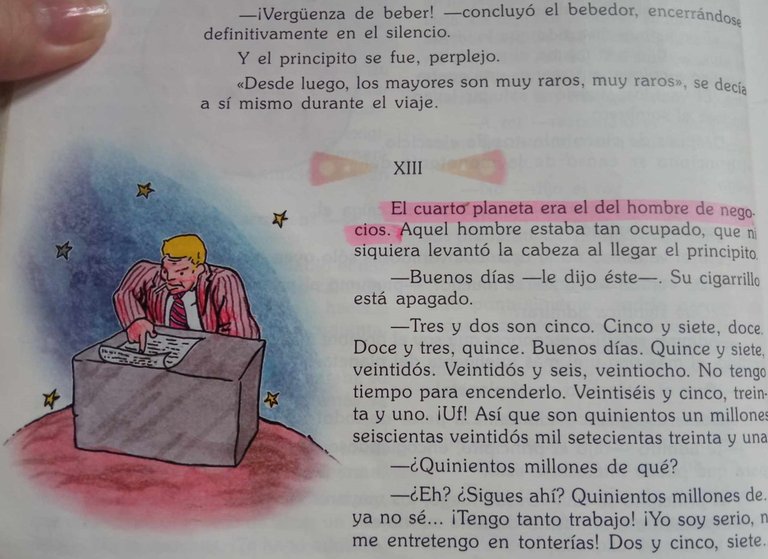
3.- Ambiente:
-Físico: En la obra se señalan varios ambientes pero los más relevantes son el Desierto del Sahara, lugar donde el piloto y el principito se conocieron, y el asteroide B-612, lugar donde el principito vive con su rosa.
-Psicológico: Principalmente hay que resaltar que esta historia a pesar de estar basada en un niño, está dirigida más que todo a los adultos, o sea, al niño que vive en ellos pero que en la mayoría de los casos está dormido, u olvidado. En su contexto se refleja un niño solitario en busca de amigos, y que le formula muchas preguntas a cada adulto que encuentra en su camino, ya que no logra comprenderlos. También se ponen de manifiesto valores y desvalores en el mundo, y la incomprensión hacia el piloto desde la infancia.
4.- Secuencias o acciones
-El piloto comienza narrando detalles de su niñez y su experiencia como dibujante.
-El avión del piloto cae en el Desierto del Sahara.
-El piloto tiene su primer encuentro con el principito en el desierto.
-El narrador comienza a relatar la historia del principito cuando vivía en su planeta, cómo salió de allí, qué lugares visitó y a quiénes conoció durante el viaje.
-El principito regresa a su planeta.

5.- Tiempo:
La obra se desarrolla en tiempo pasado, porque el piloto narra lo que le sucedió, y aunque hay partes del relato donde se habla en tiempo presente, toda la historia está narrada en tiempo pasado.

💕 ANÁLISIS EN BASE AL DISCURSO
1.- Perspectiva del narrador: En esta historia se reflejan dos perspectivas; un narrador protagonista (en 1° persona), que inicia la obra narrando fragmentos de su propia vida, y de su encuentro con el principito, y un narrador omnisciente (en 3° persona), que relata la historia del principito.
2.- Registros del habla: Narración, descripción, y diálogo.

💕 ANÁLISIS DE ELEMENTOS EXTRA-LITERARIOS
1.- Biografía del autor.
Antoine de Saint- Exupèry fue un escritor de novelas y aviador de origen francés, que estuvo presente en la Segunda Guerra Mundial. Era el tercero de 5 hijos, de familia aristocrática, y por su padre, quien murió cuando él tenía apenas 4 años, obtuvo el título de Conde de Saint- Exupèry.
El Principito fue su obra más conocida, la cual escribió durante los días de guerra y soledad en su alma, en el año 1943, y la que fue ilustrada por él mismo. Otras obras del novelista fueron Correo del Sur, Vuelo Nocturno, Piloto de Guerra, y Carta a un Rehén, que fue escrita el mismo año de El principito.

Saint- Exupèry estuvo casado con una escritora, quien fue su musa inspiradora en la obra El Principito. Murió en pleno ejercicio de guerra, cuando su avión se supone fue derribado, y desapareció en el mar Mediterráneo… sus restos nunca fueron hallados.
2.- Rasgos de los personajes que relacionan al autor con la obra.
La soledad, el sentimiento de incomprensión de los adultos, la inquietud por los desvalores de la humanidad, el deseo de tener un amigo, poseer un amor orgulloso y egoísta, y el espíritu de aventura.
3.- Diferentes ambientes físicos donde se desarrolla la obra
El hogar del piloto en la infancia, el Desierto del Sahara, el planeta del principito, los pequeños planetas que visitó en su viaje, y el planeta Tierra.
4.- Época que transcurría al momento de realizar la obra
La segunda guerra mundial
5.- Resumen de la obra
El Principito es una novela corta infantil, aunque muchos la categorizan como un cuento crítico, se podría decir que posee un poco de cada uno de estos aspectos ya que enfoca directamente, y de manera fantasiosa, la confrontación de los valores en medio de una sociedad donde están ausentes. Inicia con una breve historia del piloto cuando era niño y la incomprensión de los adultos acerca de su deseo de ser pintor.

Años después, se ve varado en el Desierto del Sahara cuando su avión colapsó, y en ese solitario lugar conoce a un niño que se convierte en su primer amigo verdadero, y allí, en medio de una amena e interesante conversación, le relata su contacto con muchas personas, y su aventura por varios planetas antes de llegar a la Tierra.
A través de personajes como el farolero, el hombre de negocios, el vanidoso, el zorro, las rosas, el rey, el bebedor, el geógrafo, y la serpiente, el principito tuvo la oportunidad de conocer los valores y desvalores de los que se reflexiona a lo largo de la obra, y fue cuando a través de las rosas en la Tierra, conoció el egoísmo y la mentira, ya que la rosa con la que habitaba en su planeta, le había dicho que ella era única en el mundo.
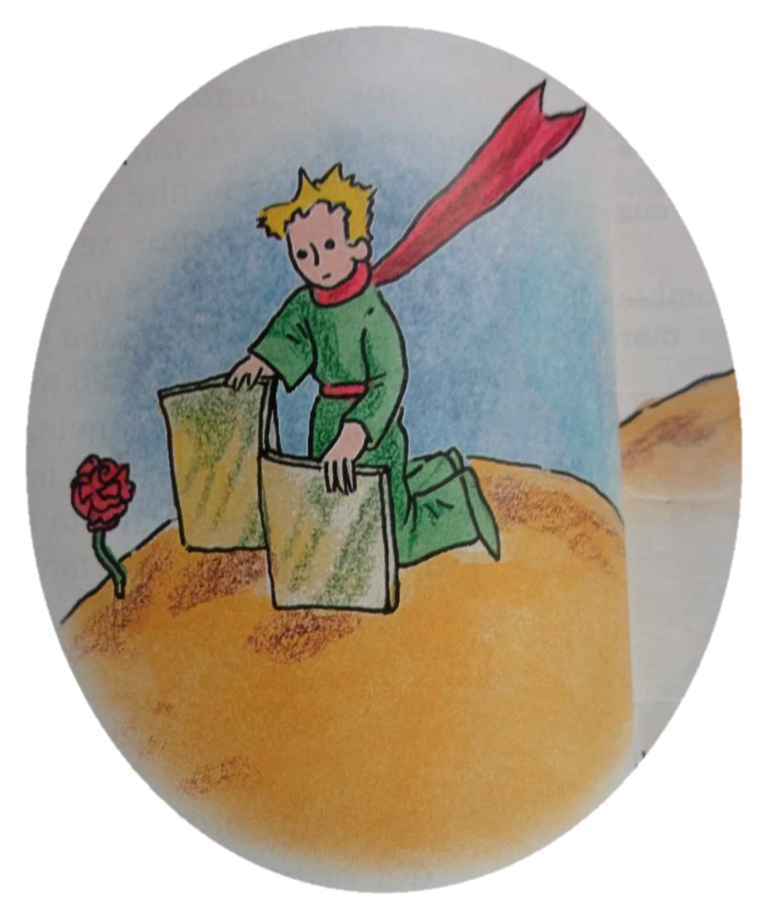
Al final de la historia, y sin que el piloto pudiera evitarlo, el pequeño príncipe conoció la maldad, al momento en que la serpiente haciendo uso de su inocencia, le dice que puede hacer que él regrese a su planeta, y de esta manera, recibe la mordedura del malvado reptil.
6.- Opinión del lector acerca de la obra
La obra El Principito siempre ha reflejado en mis pensamientos las múltiples maneras de conocer la ausencia de valores en la humanidad en contra de la importancia de tenerlos. La primera vez que la leí, estaba en el colegio, no fue un análisis profundo ya que no dejó huellas en mí hasta que la leí por segunda vez cuando mi hijo estaba estudiando, y ayudándolo a realizar el análisis, me fui enamorando no sólo del pequeño príncipe, sino de todo el contenido de la obra.
Tiempo después, vi la película, y me encantó, por eso cuando mi labor con esta asignatura me exigió una obra para trabajarla con el grupo de secundaria, no dudé en tomarla. Realmente fue una hermosa experiencia captar la atención de mis alumnos a través de esta aventura, y a la vez poder transmitirles la importancia de los valores en nuestras vidas. Por eso y más, este libro siempre será mi favorito.

💕 BANCO DE PREGUNTAS:
1.- ¿A quién dedicó Antoine de Saint- Exupèry la obra El Principito?
A su amigo León Werth, cuando era niño.
2.- ¿Cómo se llamaba la musa inspiradora de Saint- Exupèry en esta obra?
Consuelo de Saint- Exupèry, su esposa.
3.- ¿A quién se consiguió el principito en el cuarto planeta?
Al hombre de negocios.
4.- ¿En dónde se conocieron el principito y el piloto?
En el Desierto del Sahara.
5.- ¿Cómo se llamaba el planeta del Principito?
Asteroide B612
6.- ¿Qué representaba la imagen que dibujó el piloto siendo niño?
Una serpiente que se tragó un elefante.
7.- ¿Con cuál personaje el principito expresó que sí hubiera querido vivir?
Con el farolero
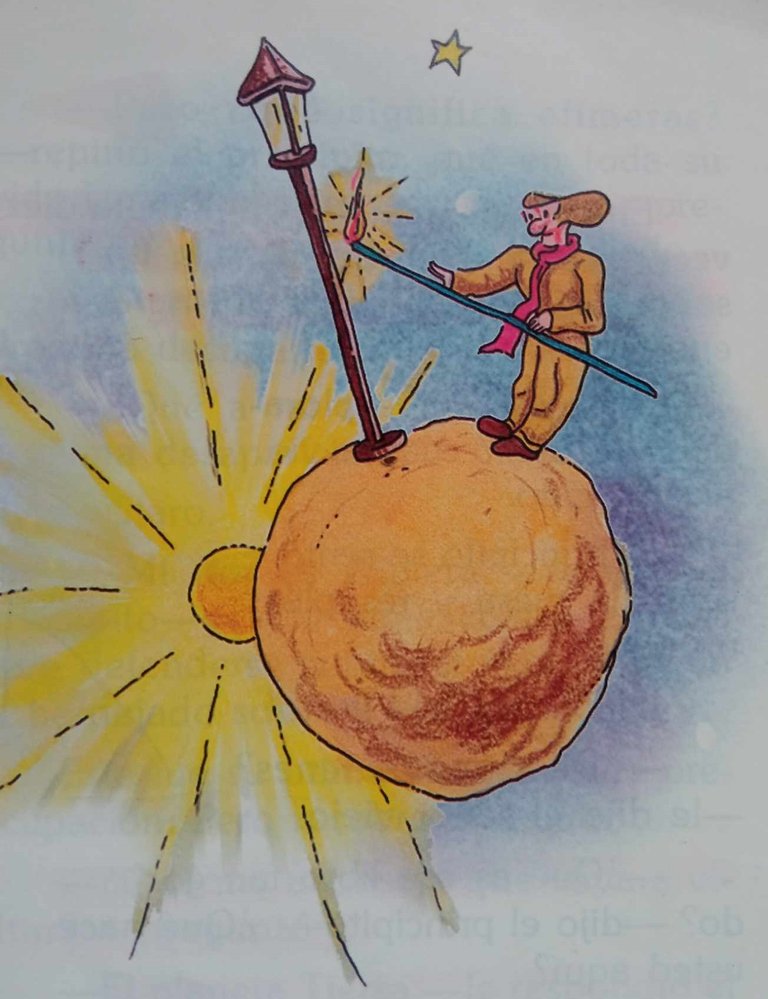
8.- ¿Cuál personaje vive solo en su planeta y se caracteriza por ser egoísta?
El vanidoso
9.- ¿De qué manera el principito regresa a su planeta?
Por la mordida de la serpiente.
10.- ¿Qué personaje le pide al principito que lo domestique?
El zorro
11.- ¿Quién narra la historia?
El piloto
12.- ¿Qué tipo de texto narrativo es El Principito?
Novela infantil
13.- ¿Cómo se llamaban los árboles que el principito arrancaba de su planeta?
Baobabs
14.- ¿Con quién vivía el principito en su planeta?
Con una rosa

Muchas gracias por visitar mi blog. Espero que hayan disfrutado este análisis y me den sus impresiones.

SOURCE OF INFORMATION CONSULTED // FUENTE DE INFORMACIÓN CONSULTADA
1.- Antoine de Saint- Exupèry - Biographies and lives // Biografías y vidas
2.- Analysis of The Little Prince - School Support for Elementary Education // Análisis de El Principito – Apoyo Escolar para Educación Básica
(This schoolwork web page is my property) // (Esta página web de trabajo escolar es de mi propiedad)
3.- Literary Works Sun Series - The Little Prince - Editorial Romor (Physical Text). // Obras Literarias Serie Sol – El Principito - Editorial Romor (Texto en Físico)

SOURCES OF IMAGES // FUENTES DE IMÁGENES
1.- Antoine de Saint- Exupèry - Biographies and lives // Biografías y vidas
2.- The rest of the content images belong to my personal archive and were taken from the book Literary Works Sun Series - The Little Prince - Editorial Romor (Physical Text). // El resto de las imágenes de contenido pertenecen a mi archivo personal y fueron tomadas del libro Obras Literarias Serie Sol – El Principito - Editorial Romor (Texto en Físico)
3.- Separadores // Separators - @eve66

Contenido Original del Autor
Aplicaciones: Canva, PhotoScape, Instagram, Inshot y Pixiz.
Traducción: Deepl Traductor www.DeepL.com/Translator
Las imágenes personales son tomadas con un dispositivo móvil Android Xiaomi Redmi 9 de mi propiedad.
Las imágenes utilizadas en los banners, minibanners, gifs y separadores, son cortesía de Pixabay.
Derechos Reservados del Autor: @annafenix (2021 – 2024)

Original Author Content
Applications: Canva, PhotoScape, Instagram, Inshot and Pixiz.
Translation: Deepl Translator www.DeepL.com/Translator
Personal images are taken with an Android Xiaomi Redmi 9 mobile device owned by me.
Images used in banners, minibanners, gifs and separators, are courtesy of Pixabay.
© Copyright: @annafenix (2021 - 2024)

